Celebrating a century of Fort Wilkins as a state park
By BARRY JAMES
Historian
Michigan History Center
This summer, Fort Wilkins, located a mile east of the village of Copper Harbor in Keweenaw County, is turning 100 years old as a historic state park.
Built in 1844, Fort Wilkins was intended to keep law and order during Michigan’s copper rush. The fort complex includes 19 buildings, 12 of them original structures from the 1840s.
Today, the fort serves as an excellent example of a mid-19th-century military post.
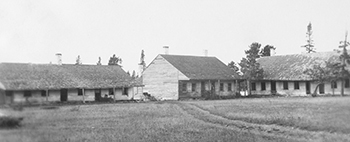
The fort was garrisoned for just five years, from 1844-46 and 1867-1870.
This area at the tip of the Keweenaw Peninsula has always attracted visitors. After the soldiers left, the fort became a popular picnic and camping ground.
When the fort began to decay, Houghton and Keweenaw counties petitioned the U.S. government to purchase the property. In 1921, the two counties bought the military garrison for $2,000.
In July 1923, 53 years after the U.S. Army closed the post, the State of Michigan acquired Fort Wilkins as a state park.
After decades without use, the fort buildings were in poor condition.
A contemporary report provides an excellent description of the property: “Time and weather have played havoc with the buildings. Their shingles are nearly all gone … in some of the porches, small trees are growing in lieu of floors, doors and portions of the building(s) have been used by campers for fuel. The once imposing flag staff has met the same fate ...”
The willingness of the Michigan Department of Conservation (the precursor of the Michigan Department of Natural Resources), and particularly of P.J. Hoffmaster, the then-director of the department’s parks division, to preserve Fort Wilkins was soon revealed.
|
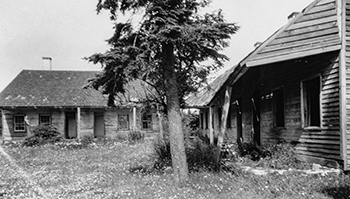
During one of his earliest inspection trips, Hoffmaster declared that the parks division desired to “restore Fort Wilkins to its original state” and planned to “restore all of the buildings surrounding the parade grounds.”
Also, development of more sanitary facilities was to be included by adding two toilets and placing “several tables … outside the stockade,” along with building cement fireplaces to aid park campers and visitors.
The Department of Conservation hired Charles Beatty as the park’s first superintendent. Beatty, a former surface foreman at the Ahmeek copper mine, lived year-round in the east officer’s quarters with his family.
Beatty served in the position from 1923 to 1936.
Summers were spent keeping an eye on the park and visitors, and during winters Beatty trapped animals for fur and repaired building interiors.
By 1928, work crews led by Beatty had stabilized fort buildings, repaired roofs and foundations, rebuilt porches and replaced windows, doors, floors and fireplaces. Wooden stockade pickets, once scavenged for firewood, once again enclosed the fort.
The WPA
During the last years of the Great Depression, federal funding from the Works Projects Administration enabled the state of Michigan to restore Fort Wilkins more thoroughly. The work was carried out from 1939 to 1942 and was part of a larger government effort to relieve nationwide unemployment.
|
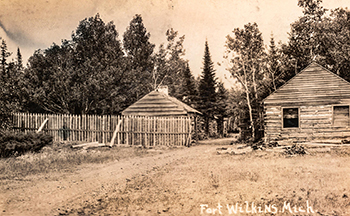
Combined with other park improvements, the work provided much-needed employment for economically depressed Keweenaw County. Federal relief efforts were linked to Upper Peninsula road improvements, which made tourist attractions like Fort Wilkins more accessible and benefited the regional economy.
The Department of Conservation Parks Division hired Donald W. Dow, Sr. to manage Fort Wilkins State Park during the WPA project. Dow and his young family remained at the fort for 11 years (1936-1947), longer than any soldier had.
In a 1984 interview Dow recalled, “Most of (the work) was just looking at what was here and replacing it.”
The WPA project stabilized chimneys and stone foundations; replaced roofs, rotted timbers, siding and porches; repaired plaster and painted buildings inside and out.
WPA crews cut timber, peeled bark and hewed the logs by hand – often using the same methods that soldiers had used almost 100 years earlier.
“These men were hard workers,” Dow remembered. “A lot of them were crippled with arthritis from working in the mines, but they were skilled – skilled with an ax.”
|
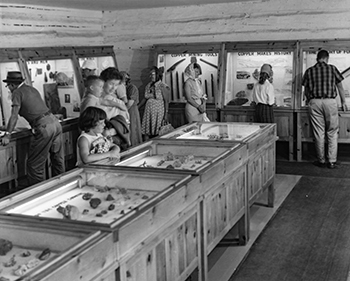
Men were paid $33 a month. The truck drivers received $40 a month, while the straw bosses and superintendent were paid more.
The state coordinator for the WPA project, architect G.D. Jones, worked closely with Department of Conservation staff to ensure a historically accurate restoration of Fort Wilkins.
Carpenter and blacksmith shops were set up on-site to duplicate original fixtures.
WPA architects prepared measured drawings of two surviving married enlisted men’s quarters that were beyond repair. Crews led by field supervisor Victor Oja carefully dismantled and rebuilt the cabins, reusing original materials whenever possible.
Work wasn’t limited to the fort buildings.
Workers planted 1,350 deciduous trees, 2,500 shrubs and 8,000 evergreen trees in 1941 and another 3,500 deciduous trees, 4,120 shrubs and 20,000 evergreens in 1942.
Additional improvements at the park included a new entrance road, parking area, park store, picnic and campground development, water system, toilet buildings, tables and a pump house.
Interpretation then and now
During the 1950s, extensive research and planning went into creating exhibits that tell the story of the time period in various rooms of the fort.
|

Fort Wilkins State Park manager Louis England, whose tenure at the park lasted from 1947 to 52, along with Department of Conservation Parks and Recreation Division Chief Arthur Elmer, consulted with Carroll Paul from the Marquette County Historical Society and Museum.
Paul had experience with interior decorating and helped collect, catalogue and display furniture and other objects in the officer’s quarters. Many of the furnishings she collected and installed are still on display and cared for by the Michigan History Museum collections staff.
In addition to period rooms, the fort had an extensive rock and mineral display in the east barracks. Other attractions included relics from the fort, original stockade posts and reconstructed married enlisted men’s cabins.
In 1976, the Michigan History Division (now Michigan History Center) celebrated the nation’s bicentennial by developing a living history program. Now in its 47th year, the first-person, role-playing program continues to bring life to the historic site for park visitors.
This summer, in celebration of the fort’s 100 years since becoming a state park, the Michigan History Center opened a new period room exhibit in the west officers’ quarters.
The exhibit consists of high-quality reproduction period room furniture and objects of the 1860s. Visitors can sit on a felt sofa, enjoy reading books of the Civil War era and try their hand sitting at a secretary and writing with a steel pen.
|
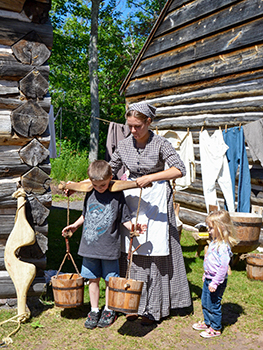
Coming attractions will include 13 new outdoor interpretive signs and a new Michigan Historical Marker.
Planning is under way for a new exhibit entitled “Fort Wilkins Becomes a State Park” to be installed in the west mess hall building. Funding for the exhibit will come from a Keweenaw National Historical Park Advisory Commission grant, secured with matching funds from the Fort Wilkins Natural History Association.
Check out a historic article about park attendance.
For the past century, Fort Wilkins Historic State Park has offered visitors a rare and engrossing look into military life in the northernmost part of Michigan.
Stepping through the gates of the fort is like traveling through time, bringing the past into clear focus right before your eyes.
Find out more about the many things to do at Fort Wilkins Historic State Park.
|
Check out previous Showcasing the DNR stories in our archive at Michigan.gov/DNRStories. To subscribe to upcoming Showcasing articles, sign up for free email delivery at Michigan.gov/DNREmail.
Note to editors: Contact: John Pepin, Showcasing the DNR series editor, 906-226-1352. Accompanying photos and a text-only version of this story are available below for download. Caption information follows. Credit Michigan History Center.
Text-only version of this story.
1910s-1 and 1910s-2: A historic, black-and-white photo shows dilapidated structures at Fort Wilkins circa 1910.
1930s: A historic, black-and-white photo from Fort Wilkins Historic State Park shows buildings during the 1930s.
1950s: Visitors are shown viewing interpretive displays and other exhibits in a barracks building at Fort Wilkins Historic State Park during the 1950s.
Parlor: A restored parlor area is shown from Fort Wilkins Historic State Park in 1953.
Restore: New 1860's officers' quarters reproduction parlor is shown at Fort Wilkins Historic State Park.
View: A modern bird's eye view of Fort Wilkins, including Lake Fannie Hooe, is shown.
Sign: The park entrance sign at Fort Wilkins Historic State Park during the 1940s and 1950s.
Woman: A costumed interpreter helps a young visitor try on a wooden yoke used to haul water to the fort.
|